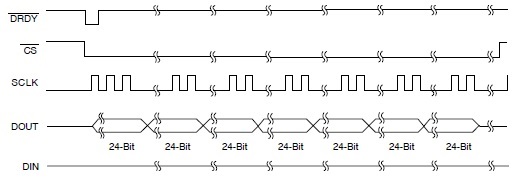Application:
F28035 interfaces through SPI-B with a slave device. A low state in a Slave's pin indicates there's data to be read.
Then the 28035 must provide the clock signal, low the CS pin and read the slave's DOUT pin.
The data is 24 bit per word, having 7 words per read making a total of 168bits thread. Every thread is read 4,000 times /secc. The diagram below describes it:
Probelm:
I try to use the FIFO SPI code example in order to store 3 bytes of 8bits each one. That would have provided the equivalent to one word each time, but I couldn't make it work despite I tried a lot of different modifications in the code, including different register setups. I spent a lot of time trying to make this work.
I ended up reading 1 byte per byte but this is more time consuming.
Help needed.
I need a base code that allow me to read a set of 3 bytes from the Slave, because that will save precious time that would be used for calculations instead of SPI driving.


